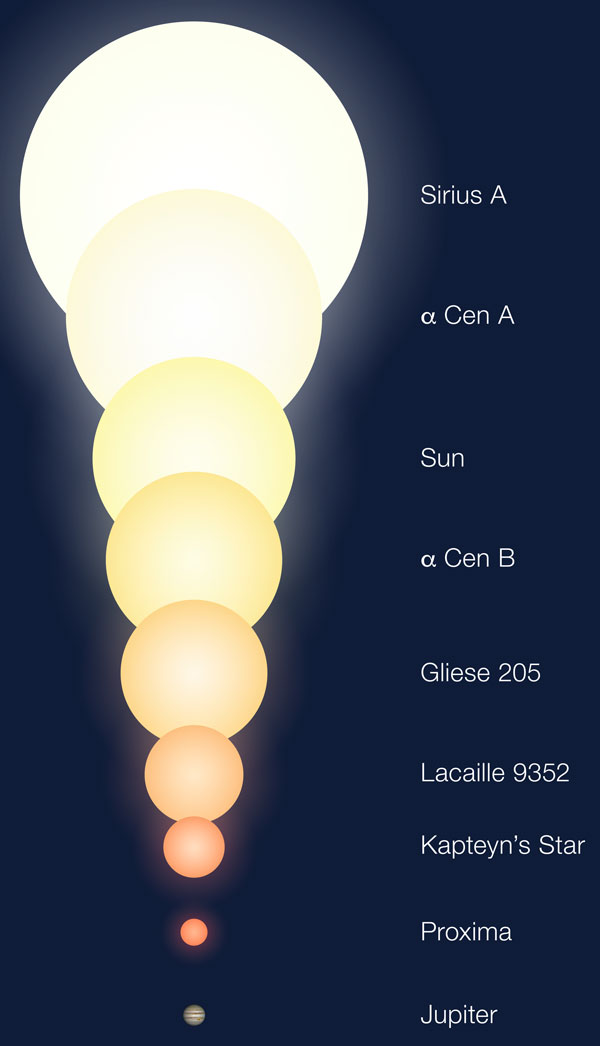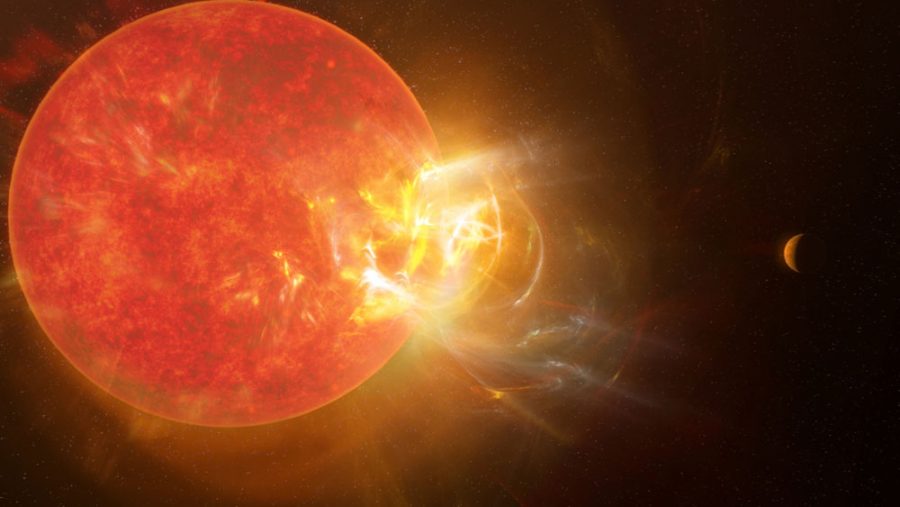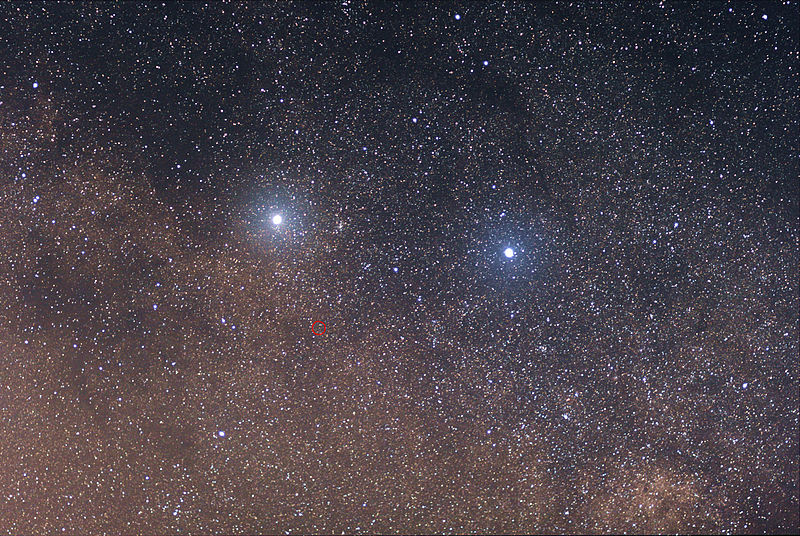Proxima Centauri is the dimmest and smallest of the Alpha Centauri system, but it has the honor of being the nearest star.
Proxima Centauri Vitals
| Official name (IAU-approved) | Proxima Centauri |
| Other Designations | Alpha Centauri C, HIP 70890 |
| Nicknames | -- |
| Apparent Magnitude | 11.13 |
| Distance from Earth | 4.24 light-years |
| Type | M5.5 |
| Color | Red |
| Mass | 0.123 M☉ |
| Radius | 0.15 R☉ |
| Constellation | Centaurus |
| Right Ascension | 14h 29m 43s |
| Declination | -62° 40' 46” |
| Multiple system? | Yes, third member of the Alpha Centauri system |
| Variable star? | Yes, eruptive variable |
| Exoplanets status | Two known exoplanets |
| Probable fate | White dwarf |
Physical Characteristics
Of all the stars in the universe — and there are untold billions of them — Proxima Centauri, a run-of-the-mill red dwarf star, is closest to the Sun. It’s about 14% the Sun’s diameter and located in the southern celestial sky.

ESO
But wait, you may be thinking, I thought Alpha Centauri was the closest star to the Sun. Well, that’s basically true, too. Even casual space enthusiasts are familiar with the name Alpha Centauri. Located a “mere” 4.35 light-years away, it’s indeed the closest of the Sun’s stellar neighbors, but this isn’t the whole story. Although Alpha Centauri appears to be a singleton to the unaided eye, closer inspection shows that it’s actually a system of three stars. Two of them, Alpha Centauri A and B (officially named Rigil Kentaurus and Toliman, respectively), are a binary pair that are roughly the same size as the Sun. We see the combined light of these two stars when we’re looking at Alpha Centauri.
But the third member of the group, separated from the other two by a considerable distance, is Alpha Centauri C — or as it’s officially known, Proxima Centauri. Proxima is about 4.24 light-years from our neighborhood, so it’s this stellar runt that currently holds the precise distinction of “closest.” Despite its proximity, Proxima is quite dim, partly because it outputs much of its energy at infrared wavelengths, which are invisible to human eyes.

S. Dagnello / NRAO / AUI / NSF
But don’t be too cavalier with the word “close,” as the distances involved are here still astounding: Proxima is 40,208,000,000,000 km, or 268,770 astronomical units (a.u.), from us. Don’t make any vacation plans just yet!
Proxima is about 13,000 a.u. from its companions, circling them every 550,000 years in a slow and enormous orbit. The laws of celestial mechanics dictate that objects orbiting close to their parent star (Mercury, for example) travel faster than those orbiting at a great distance (like Neptune), so Proxima’s slow pace is a product of its vast distance.
Red dwarf stars are the most common type of star in the universe, so it’s not surprising to find Proxima (and Barnard’s Star) in our immediate vicinity. Proxima Centauri has a feisty personality, as it’s prone to occasional fiery outbursts of stellar flares, but it’s also an enduring star. Because of their small size, red dwarfs are cooler, and they don’t expend their fuel sources as rapidly as larger stars. So even though they have fewer atoms to fuse, the rate of consumption is so slow that these fuel sources can last a very long time. If Proxima Centauri continues its fusion at the current rate, it will continue shining for several trillion years!

ESO / M. Kornmesser
Proxima hosts two exoplanets: a rocky but likely airless world dubbed Proxima Centauri b, with a mass of about 1.27 Earths and an orbital period of just 11 days, and Proxima Centauri c, a world probably around the size of Neptune.
Origin / Mythology
No ancient culture would have been aware of Proxima Centauri’s existence — the star is simply too faint to see without optical aid. But the Alpha Centauri system as a whole shines at 0.28 magnitude and is a major component of the large Centaurus constellation — so there’s no shortage of myths and legends surrounding Centaurus and Alpha Centauri in particular.
Greco-Roman traditions are responsible for the constellation’s modern name and basic shape — that of a mythological half horse/half man creature. The specific centaur depicted by the starry outline is probably a centaur named Chiron, a wise individual and tutor of legendary heroes like Hercules, Achilles, Jason, and others.
Outside the Mediterranean, Alpha Centauri appeared in other constellations and myths. The Incan culture of South America combined some of the dark regions of the Milky Way’s Great Rift to form an image of a mother llama, with Alpha Centauri and Hadar (Beta Centauri) as the animal’s eyes (see the August 2021 issue of Sky & Telescope for more of these fascinating “dark constellations”). Some Aboriginal Australian groups instead saw Alpha and Beta Centauri as sharks chasing a stingray, while some African traditions envisioned Alpha and Beta Centauri as the neck of a giraffe with the Southern Cross as its head. Native Hawaiians called Alpha Centauri Kamaile Hope and used it and Hadar as pointers to the Southern Cross — a handy trick stargazers still use today.
Even though the utilitarian label Alpha Centauri has become the system’s popular name, meaning simply that it’s the brightest star of the Centaurus constellation, you’ll also see the primary star referred to as Rigil Kentaurus. That’s an Arabic phrase, meaning “foot of the centaur,” with similar etymology to the more familiar Rigel that marks Orion’s left foot, and it’s now the star’s official name according to the International Astronomical Union. Alpha Centauri B’s official name is Toliman, another traditional name for the system.
How to See Proxima Centauri

Sky & Telescope
It’s possible that future technology could allow for robotic exploration of nearby stars, and Proxima Centauri would make an interesting candidate. But you don’t have to wait for the future to start your own exploration of the nearby red dwarf. You just need the right location and — just as importantly — the right telescope.
You’ll need to be south of roughly 30°N latitude to see Proxima. The further south you go, the higher the dim star rises out of the turbulent air near the horizon, and the easier it will be to see. So while it’s theoretically possible to see Proxima from southern U.S. mainland states like Florida or Texas, for stargazers in Australia, Central and South America, and parts of Africa and Asia, the view should be excellent.
Proxima can make for an interesting telescopic challenge, especially for experienced amateurs who are used to finding dim objects by “star-hopping.” The binary A and B pair are easy enough to split visually, but Proxima is separated a full 2° from Alpha Centauri AB, so it requires a bit of searching. How big will your telescope need to be? While local atmospheric and light pollution conditions will always play a factor, a 6-inch or larger reflector should be able to pull in the 11th-magnitude Proxima. This can be a great project for astrophotographers as well, who can better record the star’s red color.
Proxima may not look like much through your telescope, especially compared to the much brighter A and B stars, but it can be interesting to reach out and gather the light of this dim star that is so very far — but not that far — away. Have you ever spotted our nearest stellar neighbor?

Wikimedia Commons
Daniel Johnson is a Wisconsin-based freelance writer and professional photographer and the co-author of over a dozen books. He’s a longtime amateur astronomer and fortunate enough to live in a rural region with excellent seeing conditions. You can view some of Dan’s photography (he does a lot of animals!) at www.foxhillphoto.com
 2
2









Comments
Rod
November 30, 2021 at 11:37 am
I enjoyed this report. I note about the exoplanets mentioned. "Proxima hosts two exoplanets: a rocky but likely airless world dubbed Proxima Centauri b, with a mass of about 1.27 Earths and an orbital period of just 11 days, and Proxima Centauri c, a world probably around the size of Neptune."
Proxima Centauri is 1.3 pc so a telescope with one arcsecond resolution, sees 1.3 au diameter size. Any exoplanets from about one arcsecond from the star and farther out would be easy to see, if they existed.
You must be logged in to post a comment.
wrdiffin
August 18, 2023 at 7:12 pm
Proxima Centauri b orbits Proxima at a distance of ~0.049AU, which distance subtends an angle of 0.038 arcseconds as observed from Terra. From the same vantage Proxima b's own angular diameter is only ~0.00007 arcseconds, and even at full phase the planet's apparent magnitude cannot appear brighter than 37th at best.
Even the Center for High Angular Resolution Astronomy array on Mount Wilson can only resolve stellar discs at a resolution of 0.0002 arcseconds, and even then it has a limiting magnitude of about 8th, and is situated too far north to observe Proxima Centauri anyway. And even the Hubble Space Telescope can only observe objects down to 30th magnitude, and the James Webb Space Telescope can only resolve down to 0.07 arcseconds.
Proxima b was only detected at all by precision Doppler spectroscopic measurements of the planet's gravitational effects on Proxima's radial velocity. Proxima c's existence remains unproven, and Proxima d orbits even closer to Proxima than Proxima b does.
Therefore it would not be easy to see the planetary system of Proxima Centauri from Earth with an amateur telescope of ~1.0 arcsecond resolution. It is impossible even with the most sophisticated and powerful instrumentation yet crafted by humanity. But Proxima's planetary system certainly still exists nonetheless.
You must be logged in to post a comment.
You must be logged in to post a comment.